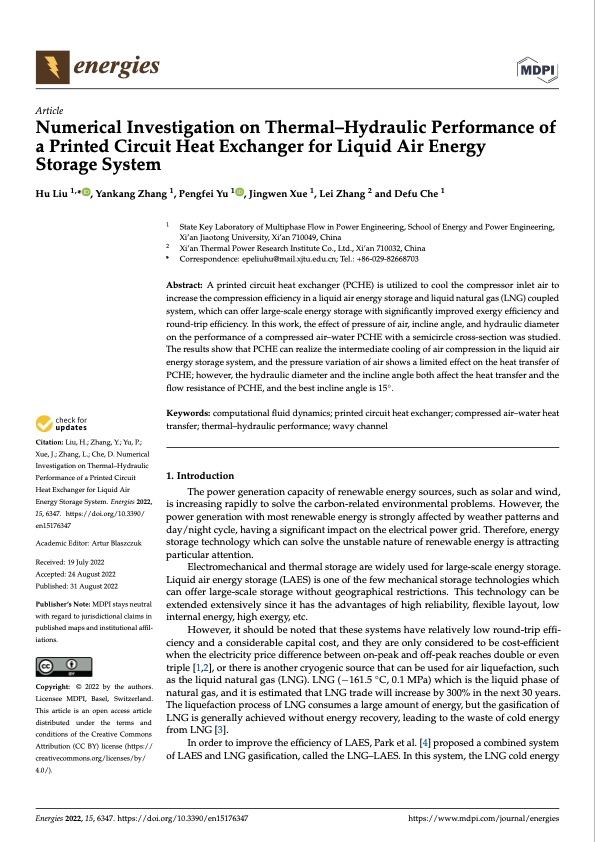
PDF Publication Title:
Text from PDF Page: 001
energies Article Numerical Investigation on Thermal–Hydraulic Performance of a Printed Circuit Heat Exchanger for Liquid Air Energy Storage System Hu Liu 1,* , Yankang Zhang 1, Pengfei Yu 1 , Jingwen Xue 1, Lei Zhang 2 and Defu Che 1 1 State Key Laboratory of Multiphase Flow in Power Engineering, School of Energy and Power Engineering, Xi’an Jiaotong University, Xi’an 710049, China Xi’an Thermal Power Research Institute Co., Ltd., Xi’an 710032, China Citation: Liu, H.; Zhang, Y.; Yu, P.; Xue, J.; Zhang, L.; Che, D. Numerical Investigation on Thermal–Hydraulic Performance of a Printed Circuit Heat Exchanger for Liquid Air Energy Storage System. Energies 2022, 15,6347. https://doi.org/10.3390/ en15176347 Academic Editor: Artur Blaszczuk Received: 19 July 2022 Accepted: 24 August 2022 Published: 31 August 2022 Publisher’s Note: MDPI stays neutral with regard to jurisdictional claims in published maps and institutional affil- iations. Copyright: © 2022 by the authors. Licensee MDPI, Basel, Switzerland. This article is an open access article distributed under the terms and conditions of the Creative Commons Attribution (CC BY) license (https:// creativecommons.org/licenses/by/ 4.0/). Abstract: A printed circuit heat exchanger (PCHE) is utilized to cool the compressor inlet air to increase the compression efficiency in a liquid air energy storage and liquid natural gas (LNG) coupled system, which can offer large-scale energy storage with significantly improved exergy efficiency and round-trip efficiency. In this work, the effect of pressure of air, incline angle, and hydraulic diameter on the performance of a compressed air–water PCHE with a semicircle cross-section was studied. The results show that PCHE can realize the intermediate cooling of air compression in the liquid air energy storage system, and the pressure variation of air shows a limited effect on the heat transfer of PCHE; however, the hydraulic diameter and the incline angle both affect the heat transfer and the flow resistance of PCHE, and the best incline angle is 15◦. Keywords: computational fluid dynamics; printed circuit heat exchanger; compressed air–water heat transfer; thermal–hydraulic performance; wavy channel 1. Introduction The power generation capacity of renewable energy sources, such as solar and wind, is increasing rapidly to solve the carbon-related environmental problems. However, the power generation with most renewable energy is strongly affected by weather patterns and day/night cycle, having a significant impact on the electrical power grid. Therefore, energy storage technology which can solve the unstable nature of renewable energy is attracting particular attention. Electromechanical and thermal storage are widely used for large-scale energy storage. Liquid air energy storage (LAES) is one of the few mechanical storage technologies which can offer large-scale storage without geographical restrictions. This technology can be extended extensively since it has the advantages of high reliability, flexible layout, low internal energy, high exergy, etc. However, it should be noted that these systems have relatively low round-trip effi- ciency and a considerable capital cost, and they are only considered to be cost-efficient when the electricity price difference between on-peak and off-peak reaches double or even triple [1,2], or there is another cryogenic source that can be used for air liquefaction, such as the liquid natural gas (LNG). LNG (−161.5 ◦C, 0.1 MPa) which is the liquid phase of natural gas, and it is estimated that LNG trade will increase by 300% in the next 30 years. The liquefaction process of LNG consumes a large amount of energy, but the gasification of LNG is generally achieved without energy recovery, leading to the waste of cold energy from LNG [3]. In order to improve the efficiency of LAES, Park et al. [4] proposed a combined system of LAES and LNG gasification, called the LNG–LAES. In this system, the LNG cold energy 2 * Correspondence: epeliuhu@mail.xjtu.edu.cn; Tel.: +86-029-82668703 Energies 2022, 15, 6347. https://doi.org/10.3390/en15176347 https://www.mdpi.com/journal/energiesPDF Image | Thermal–Hydraulic Performance of a Printed Circuit Heat Exchanger

PDF Search Title:
Thermal–Hydraulic Performance of a Printed Circuit Heat ExchangerOriginal File Name Searched:
energies-15-06347.pdfDIY PDF Search: Google It | Yahoo | Bing
Turbine and System Plans CAD CAM: Special for this month, any plans are $10,000 for complete Cad/Cam blueprints. License is for one build. Try before you buy a production license. More Info
Waste Heat Power Technology: Organic Rankine Cycle uses waste heat to make electricity, shaft horsepower and cooling. More Info
All Turbine and System Products: Infinity Turbine ORD systems, turbine generator sets, build plans and more to use your waste heat from 30C to 100C. More Info
CO2 Phase Change Demonstrator: CO2 goes supercritical at 30 C. This is a experimental platform which you can use to demonstrate phase change with low heat. Includes integration area for small CO2 turbine, static generator, and more. This can also be used for a GTL Gas to Liquids experimental platform. More Info
Introducing the Infinity Turbine Products Infinity Turbine develops and builds systems for making power from waste heat. It also is working on innovative strategies for storing, making, and deploying energy. More Info
Need Strategy? Use our Consulting and analyst services Infinity Turbine LLC is pleased to announce its consulting and analyst services. We have worked in the renewable energy industry as a researcher, developing sales and markets, along with may inventions and innovations. More Info
Made in USA with Global Energy Millennial Web Engine These pages were made with the Global Energy Web PDF Engine using Filemaker (Claris) software.
Sand Battery Sand and Paraffin for TES Thermo Energy Storage More Info
| CONTACT TEL: 608-238-6001 Email: greg@infinityturbine.com | RSS | AMP |